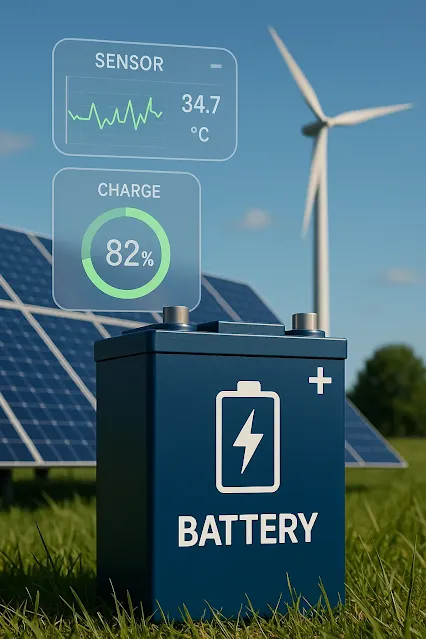The Vital Role of Battery Monitoring Systems in Modern Energy Storage Applications
Energy Storage Systems (ESS) have become increasingly critical in recent
years, especially in scenarios where energy availability is intermittent.
Among the most essential technologies for energy storage are batteries.
These systems support everything from personal devices such as smartphones to home applications like computers and UPS units and extend to large-scale industrial uses including the storage of electricity generated from renewable energy sources like solar energy, wind energy, hydrogen power, and other green technologies.
📽️ Watch this short video summary of the topic:
Why Energy Storage Matters in Renewable Energy Systems
The importance of battery-based energy storage systems becomes evident when integrating renewable energy sources. These sources—such as solar radiation, wind, and hydrogen—are inherently dependent on environmental conditions, making them unreliable at certain times.For instance, cloud cover can block sunlight or wind speeds may drop, reducing the energy output from solar panels or wind turbines. To ensure continuous and efficient operation, battery systems must be monitored around the clock.
Various environmental and operational factors can negatively impact battery performance. Key influences include temperature fluctuations, charging conditions, and discharge cycles. Accurate tracking of these parameters ensures optimal performance and prolongs battery lifespan.

|
| batteries monitoring sensors |
Enhancing Battery Efficiency with Smart Sensors and AI Integration
This article explores the network of devices and sensors designed to optimize battery system performance. We'll also examine the significant benefits of integrating these tools with Artificial Intelligence (AI) and Industrial Internet of Things (IIoT) technologies.The combination provides predictive maintenance capabilities, allowing systems to forecast potential failures and reduce downtime, ultimately cutting maintenance costs and extending component lifespans.
What Are Battery Monitoring Systems?
Battery monitoring systems (BMS) consist of sensors and smart devices that measure, display, and analyze battery performance parameters. When integrated with AI and IIoT, these systems deliver remarkable improvements in performance evaluation and fault prediction.This allows for efficient maintenance scheduling, reduced operational downtime, and an increase in overall project return on investment—especially in applications where battery systems are central infrastructure components.
Key Battery Parameters That Require Monitoring
1. Voltage
Voltage is one of the most crucial parameters in battery management. It represents the electric potential difference between the battery's positive and negative terminals. Continuous and accurate voltage monitoring helps detect overcharging or deep discharging conditions, which can significantly shorten battery life. Advanced systems such as Battery Management Systems (BMS) provide real-time voltage tracking and support load balancing and energy optimization.2. Current
Battery current reflects the flow of electric charge during charging and discharging cycles. Monitoring current enhances energy management and ensures safe operation. Devices like shunt resistors and short-circuit sensors offer real-time current readings, helping estimate the battery’s State of Charge (SOC). Constant current tracking allows for better maintenance planning and system stability.3. State of Charge (SOC)
The SOC indicates how much usable energy remains in a battery, usually expressed as a percentage of its total capacity. Though not directly measurable, SOC is calculated using voltage, current, and temperature data. Accurate SOC estimations prevent unexpected battery failures and help users optimize available charge usage.4. Temperature
Temperature significantly impacts battery performance and safety. In large-scale battery systems, both internal and external temperature sensors are employed to detect hot spots and prevent overheating. BMS platforms can trigger alerts when temperature thresholds are exceeded, especially in systems equipped with heating or cooling units. Proper thermal regulation extends battery life and ensures operational safety.5. Internal Resistance
Internal resistance increases naturally over time and indicates battery degradation. Higher resistance restricts current flow, raises battery temperatures, and causes voltage drops. Technologies such as Impedance Spectroscopy assess internal resistance by analyzing the battery's electrical characteristics. Another method involves applying a high short-term current and measuring voltage drop to estimate internal resistance.6. Additional Parameters
In more advanced or chemical-specific battery types, other parameters may also be monitored:General battery health (requires large datasets and complex algorithms)
Gas pressure (critical for lithium-ion and similar chemistries, where pressure sensors can issue warnings when limits are exceeded)
Practical Applications of Battery Monitoring Systems
- Renewable Energy Systems. Monitoring systems ensure smooth charging and discharging of batteries when solar or wind energy is available. These systems are vital in Energy Management Systems (EMS), which require extensive data from sensors to optimize performance and extend battery longevity.
- Peak Shaving Applications. Sensors allow precise control of charge/discharge cycles during peak hours, reducing stress on the electrical grid and extending both grid and battery lifespan.
- Backup Power and Emergency Systems. Battery systems provide emergency backup power (UPS, black start). Monitoring tools offer real-time feedback on battery performance during outages and recovery phases, ensuring reliability.
- Microgrids. In isolated energy systems or remote areas, batteries may serve as the primary power source. Monitoring ensures consistent performance, particularly when renewable generation is inconsistent.
- Electric Vehicles (EVs). As EV adoption grows, the role of battery monitoring becomes even more essential. These sensors provide drivers with real-time insights into battery status, ensuring safe driving and reliable long-distance travel.
- Demand Charge Management. In industrial zones, battery systems help reduce electricity costs during peak hours. Monitoring ensures optimal performance and protects against overuse or degradation, maximizing cost efficiency.
Summary:
Battery storage systems are the backbone of modern energy infrastructure—especially when renewable energy sources are involved. Monitoring parameters such as voltage, current, SOC, temperature, and internal resistance is critical to maintaining efficient, safe, and long-lasting battery operations.By integrating these monitoring systems with AI and IIoT technologies, organizations can unlock predictive maintenance, reduce repair costs, and boost system reliability. Applications span across microgrids, emergency power systems, EVs, demand-side management, and more.
In upcoming articles, we will explore individual battery monitoring devices in-depth, examining the advantages and limitations of each.

